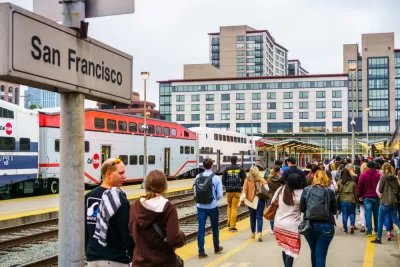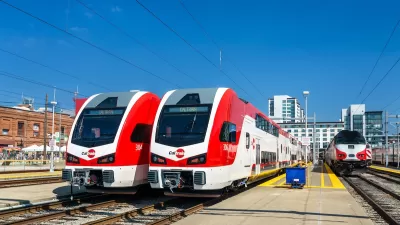The agency is seeking an additional $260 million to complete electrification of train lines between San Francisco and San Jose.

As Benjamin Schneider reports in the San Francisco Examiner, “Caltrain is on the cusp of completing its most significant upgrade since the rail line debuted in 1863. By converting its power source from fossil fuels to electricity, trains travelling between San Francisco and San Jose will be faster, more frequent and far less polluting.” But the agency needs an additional $260 million to finish the project by the target 2024 completion date.
“The project, which also includes a new signal system and other improvements, was originally budgeted for $1.9 billion, but costs ballooned to about $2.4 billion. The $462 million shortfall was partly the result of pandemic disruption, cost increases and unexpected construction issues along the nearly 160-year-old railway.” The project also had to replace its signal system to comply with federal and state standards. To secure the needed funding, “The agency’s best hope is at the state level where several Bay Area legislators have proposed a bill, AB 2197, that would appropriate $260 million to the project from the general fund.”
According to the article, electric trains will have higher frequency and more modern interiors. “Unlike today’s diesel trains, electrified Caltrain service will not produce any local pollution, so communities near the tracks will breathe cleaner air. The zero emissions trains are expected to decrease CO2 emissions by 176,000 tons annually.”
FULL STORY: Caltrain seeks $260 million to complete electrification

Planetizen Federal Action Tracker
A weekly monitor of how Trump’s orders and actions are impacting planners and planning in America.

Congressman Proposes Bill to Rename DC Metro “Trump Train”
The Make Autorail Great Again Act would withhold federal funding to the system until the Washington Metropolitan Area Transit Authority (WMATA), rebrands as the Washington Metropolitan Authority for Greater Access (WMAGA).

The Simple Legislative Tool Transforming Vacant Downtowns
In California, Michigan and Georgia, an easy win is bringing dollars — and delight — back to city centers.

The States Losing Rural Delivery Rooms at an Alarming Pace
In some states, as few as 9% of rural hospitals still deliver babies. As a result, rising pre-term births, no adequate pre-term care and harrowing close calls are a growing reality.

The Small South Asian Republic Going all in on EVs
Thanks to one simple policy change less than five years ago, 65% of new cars in this Himalayan country are now electric.

DC Backpedals on Bike Lane Protection, Swaps Barriers for Paint
Citing aesthetic concerns, the city is removing the concrete barriers and flexposts that once separated Arizona Avenue cyclists from motor vehicles.
Urban Design for Planners 1: Software Tools
This six-course series explores essential urban design concepts using open source software and equips planners with the tools they need to participate fully in the urban design process.
Planning for Universal Design
Learn the tools for implementing Universal Design in planning regulations.
Smith Gee Studio
City of Charlotte
City of Camden Redevelopment Agency
City of Astoria
Transportation Research & Education Center (TREC) at Portland State University
US High Speed Rail Association
City of Camden Redevelopment Agency
Municipality of Princeton (NJ)





























